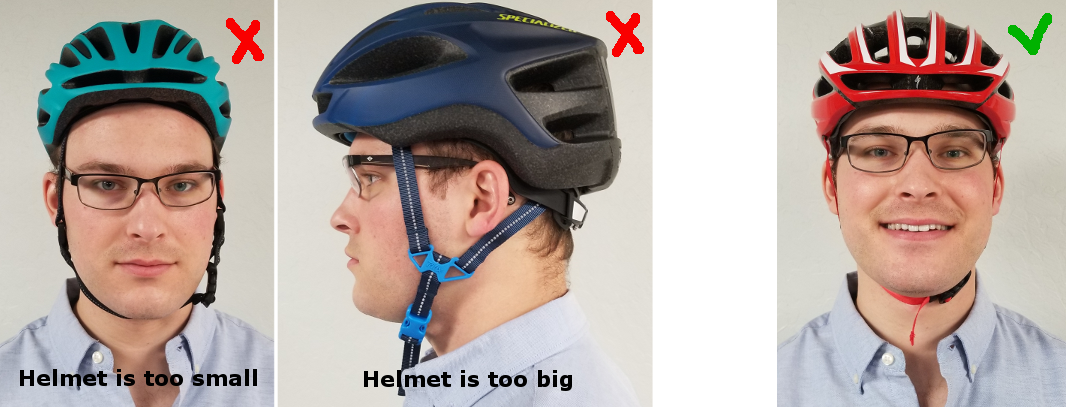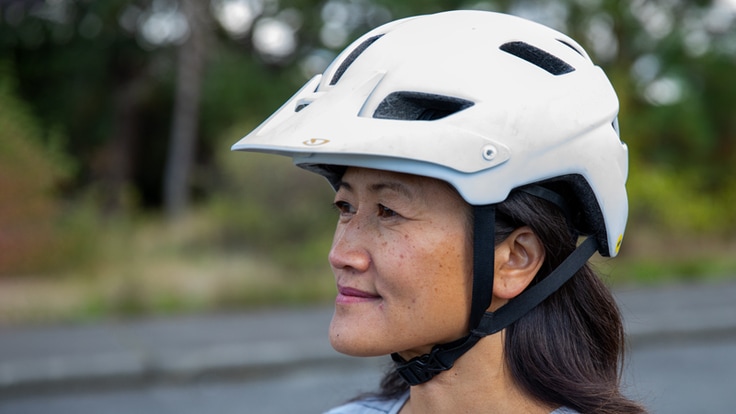To choose a bicycle helmet, ensure it meets safety standards and fits snugly on your head. Comfort and ventilation are also crucial.
Choosing the right bicycle helmet is essential for safety and comfort during rides. A helmet that meets safety standards, such as CPSC in the United States or CE in Europe, ensures protection against head injuries. A proper fit is vital; the helmet should sit level on your head, with the front edge one inch above your eyebrows.
Adjust the straps so they form a “V” under each ear. Adequate ventilation keeps your head cool, especially during long rides. Look for helmets with multiple vents and moisture-wicking pads. Prioritize comfort and style to encourage consistent use, enhancing your overall cycling experience.

Credit: www.youtube.com
Importance Of Bicycle Helmets
Bicycle helmets are essential for safety. They protect your head in accidents. Wearing a helmet can save your life. Every cyclist should wear a helmet.
Protecting Your Head
Bicycle helmets protect your head from injuries. The human head is very fragile. A fall can cause serious damage.
Helmets absorb the impact force. This reduces the risk of head injuries. Helmets prevent cuts, bruises, and skull fractures.
- Helmets have a hard outer shell.
- They have a soft inner lining.
- These materials absorb shock.
- This keeps your head safe.
Legal Requirements
Many places have helmet laws. These laws protect cyclists. You must wear a helmet in certain areas.
Check local regulations. This ensures you follow the law.
| Country | Helmet Law |
|---|---|
| USA | Varies by state |
| Canada | Varies by province |
| Australia | Mandatory nationwide |
Following the law avoids fines. It also promotes safety.
Types Of Bicycle Helmets
Choosing the right bicycle helmet is crucial for your safety. Different helmets suit different riding styles. Here are the main types of bicycle helmets to consider:
Road Helmets
Road helmets are designed for speed and aerodynamics. They are lightweight and have plenty of ventilation. This helps keep you cool during long rides. These helmets often come with sleek designs and minimalistic styles.
Key Features:
- Lightweight
- Good ventilation
- Aerodynamic design
Mountain Bike Helmets
Mountain bike helmets offer more coverage and protection. They are built to handle rough terrains and obstacles. These helmets often have visors to shield your eyes from the sun and debris.
Key Features:
- Extra coverage
- Visors
- Durable construction
Commuter Helmets
Commuter helmets are perfect for daily rides in the city. They focus on comfort and practicality. Many come with built-in lights for better visibility in traffic.
Key Features:
- Comfortable fit
- Built-in lights
- Practical design
Key Safety Features
Choosing a bicycle helmet is crucial for your safety. You need to focus on key safety features. These features ensure your helmet provides the best protection.
Impact Protection
Impact protection is the most important feature. Helmets must meet safety standards. Look for certifications like CPSC, ASTM, or EN1078. These certifications ensure your helmet can absorb impact. The helmet’s outer shell and inner foam layer work together. They protect your head in case of a fall.
Fit And Stability
A helmet must fit your head snugly. It should not wobble or move. Adjustable straps and retention systems ensure a perfect fit. Measure your head’s circumference before buying. Use the helmet’s size chart for guidance. A well-fitted helmet stays in place during an accident.
| Feature | Description |
|---|---|
| Adjustable Straps | Helps customize the fit for comfort and safety. |
| Retention System | Keeps the helmet in place. |
| Pads | Provides extra cushioning for a better fit. |
Ventilation
Ventilation is crucial for comfort. Good ventilation keeps your head cool. Look for helmets with multiple vents. Vents allow air to flow through the helmet. This prevents overheating on hot days. A comfortable rider is a safer rider.
- Look for at least 10 vents.
- Check if the vents are strategically placed.
- Ensure the vents do not compromise safety.

Credit: smf.org
Choosing The Right Size
Choosing the right size bicycle helmet is essential for safety and comfort. An ill-fitting helmet can lead to accidents and injuries. This guide will help you find the perfect fit.
Measuring Your Head
Start by measuring your head with a soft tape measure. Wrap the tape around your head, about one inch above your eyebrows. Write down the measurement in centimeters. This number will help you find the correct helmet size.
Use the table below to match your measurement with the helmet size:
| Head Circumference (cm) | Helmet Size |
|---|---|
| 52-54 | Small |
| 55-58 | Medium |
| 59-62 | Large |
Adjusting Straps
Once you have the right size, adjust the straps. The straps should form a “V” shape under your ears. They should be snug but not tight. Use the sliders to adjust the length of the straps.
Ensure the chin strap fits well. It should be tight enough to stay in place but loose enough to allow you to breathe and speak comfortably.
Ensuring A Secure Fit
Ensure the helmet sits level on your head. It should not tilt forward or backward. The front edge should be about two fingers above your eyebrows.
Perform a shake test. Shake your head from side to side. The helmet should stay in place. If it moves, tighten the straps or consider a different size.
Remember, a well-fitted helmet can save your life. Always wear your helmet while riding.
Material And Construction
Choosing the right bicycle helmet is crucial for safety. The material and construction of a helmet play a vital role. They determine the helmet’s durability, comfort, and protection level. Understanding these elements helps you make an informed decision.
Shell Materials
The outer shell of a helmet is usually made from hard plastic. Common materials include polycarbonate and ABS plastic. Polycarbonate is lightweight and offers strong protection. ABS plastic is more durable and heavier. Both materials protect against impact and penetration.
Inner Lining
The inner lining of a helmet is made from expanded polystyrene (EPS) foam. EPS foam absorbs shock and reduces impact force. Some helmets use multi-density foam for better protection. The foam should be firm yet comfortable. It should mold to your head shape for a snug fit.
Additional Padding
Additional padding enhances comfort and fit. It can be removable and washable. Some helmets have anti-microbial padding to prevent odor. Look for padding that is soft and breathable. Proper padding ensures the helmet stays secure on your head.
Certification Standards
Choosing a bicycle helmet involves more than just picking a cool design. Certification standards ensure the helmet can protect your head in an accident. Knowing these standards helps you make an informed choice.
Cpsc Certification
In the United States, the Consumer Product Safety Commission (CPSC) sets the rules. All bike helmets sold in the US must meet CPSC standards. These helmets undergo strict testing. They must pass impact, strap strength, and retention tests. Look for a CPSC sticker inside the helmet. This guarantees it meets safety requirements.
Other International Standards
Different countries have their own standards. Here are some common ones:
| Country | Standard | Key Tests |
|---|---|---|
| Europe | EN 1078 | Impact, Chin Strap |
| Australia/New Zealand | AS/NZS 2063 | Impact, Penetration |
| Canada | CAN-CSA-D113.2-M | Impact, Retention |
Make sure your helmet meets the standard for your country. These standards ensure your helmet is safe and reliable.
Additional Features
Choosing a bicycle helmet involves more than just the right fit. Additional features can enhance your safety and comfort. Let’s explore some key features to consider.
Visors
A visor can shield your eyes from sun and rain. This helps improve your visibility and comfort during rides. Some helmets come with detachable visors. This allows flexibility based on weather conditions.
Reflective Elements
Reflective elements are crucial for night riding. They make you visible to drivers and other riders. Look for helmets with built-in reflective strips or stickers. This added visibility can prevent accidents.
Integrated Lights
Integrated lights offer an extra layer of safety. They can be front or rear lights, or both. These lights often have multiple settings like steady or flashing modes. Check if the lights are rechargeable or need batteries.
| Feature | Benefits |
|---|---|
| Visors | Protects from sun and rain, detachable options |
| Reflective Elements | Enhances night visibility, prevents accidents |
| Integrated Lights | Extra safety, multiple light settings, rechargeable |
These features can make your ride safer and more enjoyable. Choose wisely based on your riding needs.
Maintaining Your Helmet
Maintaining your bicycle helmet is crucial for safety and durability. A well-maintained helmet ensures maximum protection. This section covers essential tips for keeping your helmet in top shape.
Cleaning Tips
Regular cleaning keeps your helmet hygienic and prolongs its life. Follow these steps:
- Use a soft cloth and mild soap.
- Avoid harsh chemicals or abrasive materials.
- Remove and wash the inner padding separately.
- Rinse with clean water and air dry.
When To Replace
Helmets don’t last forever. Knowing when to replace is essential:
- Replace after any significant impact.
- Check for visible cracks or damage.
- Replace every 3-5 years, even without visible damage.
- Look for wear and tear on straps and buckles.
Storage Advice
Proper storage helps maintain helmet integrity:
- Store in a cool, dry place away from direct sunlight.
- Avoid placing heavy objects on top of the helmet.
- Keep away from extreme temperatures and chemicals.
- Use a helmet bag for added protection.
| Maintenance Task | Frequency | Details |
|---|---|---|
| Cleaning | Monthly | Use mild soap and water. |
| Inspection | Before every ride | Check for cracks and damage. |
| Replacement | Every 3-5 years | Replace after any major impact. |
Maintaining your helmet ensures it serves you well. Follow these tips for a safe ride!

Credit: www.rei.com
Frequently Asked Questions
How To Measure Your Head For A Helmet?
Measure around the largest part of your head. Use a soft measuring tape. Ensure it’s level above your eyebrows.
What Type Of Helmet Is Best For Commuting?
For commuting, choose a lightweight, well-ventilated helmet. Look for one with a visor for sun protection.
How Often Should You Replace A Bicycle Helmet?
Replace your helmet every five years. If it’s damaged or involved in a crash, replace it immediately.
Do Bicycle Helmets Expire?
Yes, bicycle helmets expire. Over time, materials degrade and lose effectiveness. Check the manufacturer’s guidelines for expiration dates.
Conclusion
Choosing the right bicycle helmet ensures safety and comfort. Prioritize fit, safety standards, and style. Remember, a well-chosen helmet can save lives. Regularly inspect and replace your helmet for optimal protection. Stay informed and make safe cycling a priority.

